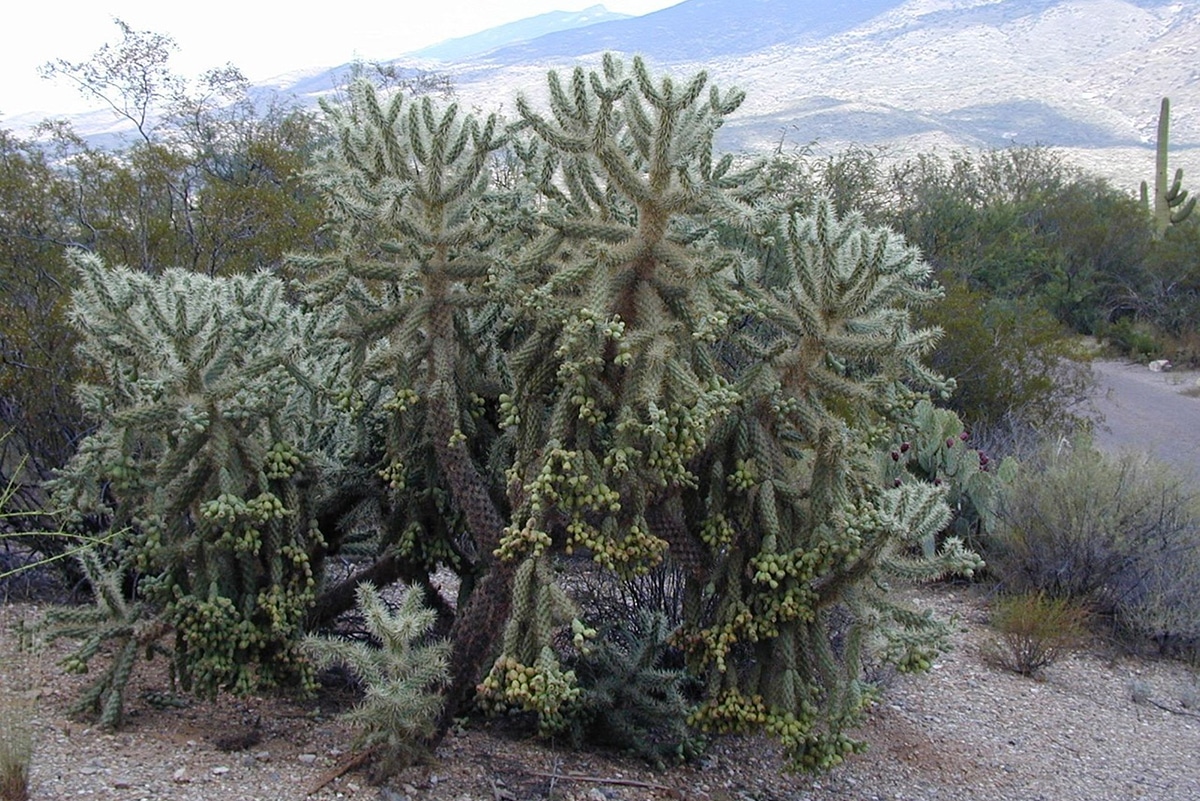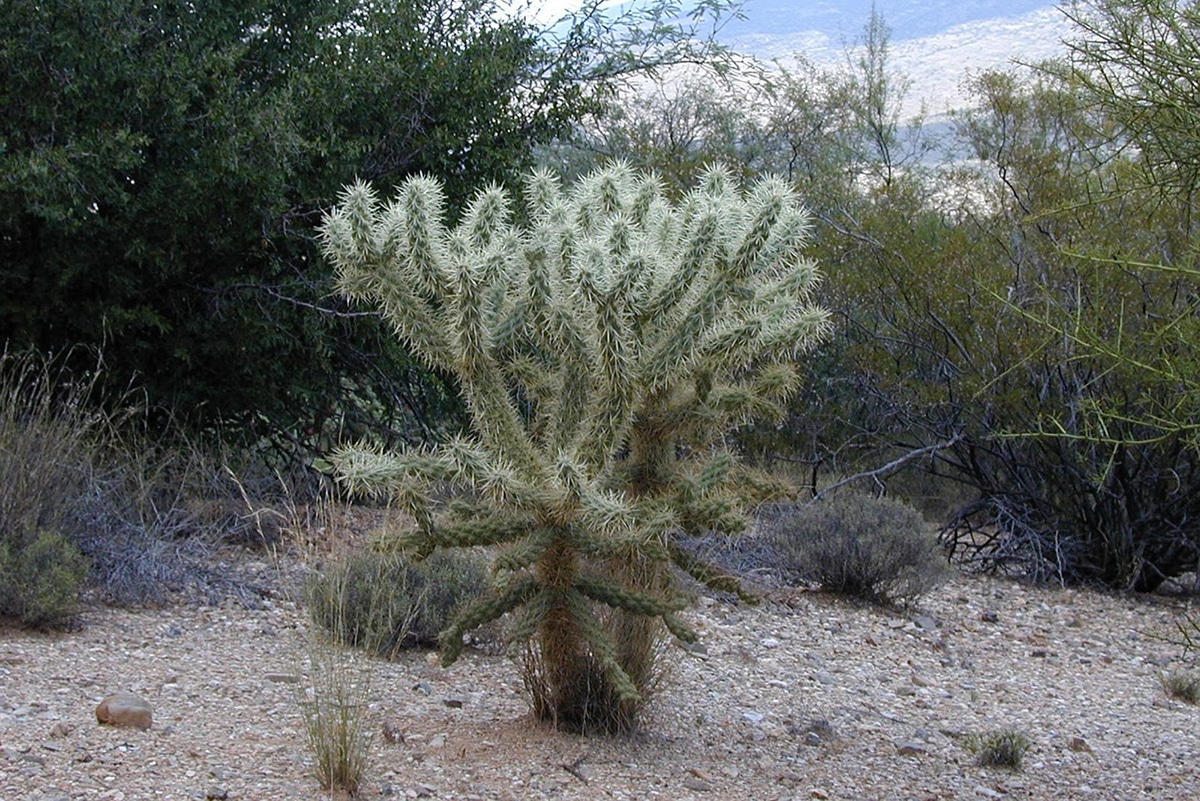
Cacti are very good to decorate our home. They are beautiful and easy to care for, what more can we ask for? However, there are some species that are considered invasive in some countries, so we must be careful. One genre that can be dangerous to introduce is Cylindropuntia, also known as twisted prickly pear.
In this post we will discuss what is this genus of cactus and what are the species that make it up. In addition, we will comment on the care that these plants require, in case you want to grow them at home (but first checking that it is allowed in your country). So do not hesitate to continue reading if these succulents have caught your attention.
What is Cylindropuntia?

When we talk about Cylindropuntia, we refer to a genus of plants, specifically cacti, belonging to the family Cactaceae. We can also find it as a subgenus of cacti Opuntia. These thorny vegetables are native to some countries belonging to South America and also to North America. This type of cactus is known as "tunas chiveras" in Venezuela, while in Mexico and the United States it is usually called "choya". In Spain it is known as “twisted prickly pear” or “warty prickly pear”. Regarding the name Cylindropuntia, this comes from the Greek and is composed of the term «cylinder«, which means «cylindrical», and «puntia«, referring to this genus of cactus. Therefore, the translated name would be "Opuntia cylindrica", which would basically be a silver similar to this genus with a cylindrical shape.
But what exactly do cacti belonging to this genus look like? Well, generally They grow in the form of small trees or highly branched shrubs. The stems are cylindrical in shape (hence the name of the genus), but on some occasions they may look more like straight discs, but always tuberculate. Their length varies greatly. As for the flowers of these vegetables, they are normally yellowish green, magenta, bronze, yellow or red.
It should be noted that the cacti belonging to this genus usually have spherical fruits that are slightly cylindrical, which, on some occasions, can be disc-shaped. They are generally dry or meaty. Depending on the species, these fruits may have thorns. They tend to be red with greenish, yellowish or brownish tones when they begin to dry. Regarding the seeds, these are usually yellow to brown, always with a pale tone, even gray. They are flattened in shape and their diameter ranges from 2,5 to 5 millimeters.
Species
Now that we know what the plants belonging to the genus are like Cylindropuntialet's see what they are the species that are part of this group. In bold we will highlight the most common:
- Cylindropuntia abyssi
- Cylindropuntia acanthocarpa
- Cylindropuntia alcahes
- Cylindropuntia anteojoensis
- Cylindropuntia arbuscula
- Cylindropuntia bigelovii
- cylindropuntia californica
- Cylindropuntia calmalliana
- Cylindropuntia caribaea
- Cylindropuntia cedrosensis
- Cylindropuntia cholla
- Cylindropuntia ×congesta
- Cylindropuntia davisii
- Cylindropuntia ×deserta
- Cylindropuntia echinocarpa
- Cylindropuntia ×fosbergii
- Cylindropuntia fulgida
- Cylindropuntia ganderi
- Cylindropuntia imbricata
- Cylindropuntia ×kelvinensis
- Cylindropuntia kleiniae
- Cylindropuntia leptocaulis
- Cylindropuntia lindsayi
- Cylindropuntia molesta
- Cylindropuntia ×multigeniculata
- Cylindropuntia munzii
- Cylindropuntia ×neoarbuscula
- Cylindropuntia prolifera
- Cylindropuntia ramosissima
- Cylindropuntia rosea (formerly known as C.pallida)
- Cylindropuntia sanfelipensis
- Cylindropuntia santamaria
- Cylindropuntia spinosior
- Cylindropuntia tessajo
- Cylindropuntia ×tetracantha
- Cylindropuntia thurberi
- Cylindropuntia tunicata
- Cylindropuntia versicolor
- Cylindropuntia ×viridiflora
- Cylindropuntia ×vivipara
- Cylindropuntia whipplei
- Cylindropuntia wolfii
At this point, it should be noted that this genus is included in the Spanish Catalog of Invasive Alien Species, being above all three species of particular concern. Specifically, it is about C. imbricata, C. rosea y C. spinosior. They are vegetables that constitute a very important threat to native plants, consequently also affecting the ecosystems and habitats of the region, due to their great colonizing potential. Since they are included in the list of invasive species, the trade, traffic, transport, possession and introduction into the natural environment of plants belonging to this genus is prohibited in Spain.
Care Cylindropuntia

In the event that we live in a country where this genus is not considered invasive and we want to have one of these plants at home, it can be very useful to know what basic care they require. We can grow the cacti belonging to this group both in the garden soil and in a pot, but we will have to take into account the following aspects:
- Location: It is important to locate these plants in a sunny location, as they require a lot of direct sunlight. In the event that the vegetable is not used to it, it is recommended that it be in a semi-shady place.
- Temperature: As they are cacti, it is normal for them to require warm temperatures. Even so, it is necessary to emphasize the rusticity of these vegetables. Obviously, it will depend on the species, but in general they tolerate the cold quite well, being able to withstand even light frosts.
- Earth: The ideal for plants of this genus is that the soil is light. If it turns out to be somewhat heavy, the best we can do is mix it with perlite in equal parts. We can also use special soil for cacti that are already prepared in specialized stores.
- Irrigation: As for watering, it should be low. It should be noted that these vegetables tolerate drought much better than excess water. It is best to let the soil dry out completely before watering again. Touching the substrate we will know if it is dry or not.
- Subscriber: If we have the plant in the garden soil, it is not necessary to fertilize it. On the other hand, if we have it in a pot, we will have to do it, since the substrate is gradually running out of nutrients. For this we can apply a special fertilizer for cacti that they sell in any garden store. If it is liquid, much better. We must apply it in spring and summer, following the instructions and the dose indicated by the manufacturer. Generally, it is poured into water and watered with the mixture. It is important to only water the soil, without getting the plant wet.
I hope this information about the genre Cylindropuntia you found it interesting. Remember that, before acquiring one of these plants, you must find out if it is allowed to grow it in your country, since it is a quite invasive genus and can harm entire ecosystems.